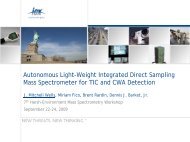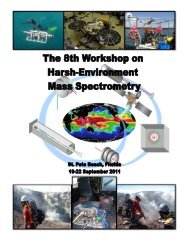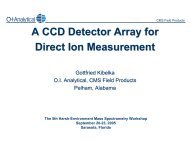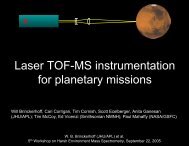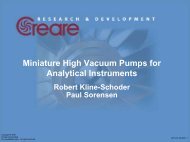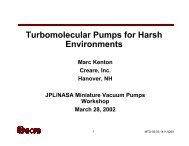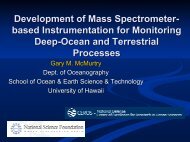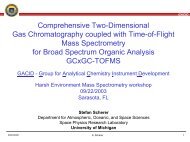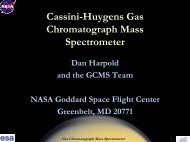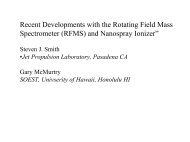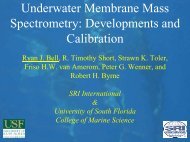Novel ion traps using planar resistive electrodes: implications for ...
Novel ion traps using planar resistive electrodes: implications for ...
Novel ion traps using planar resistive electrodes: implications for ...
Create successful ePaper yourself
Turn your PDF publications into a flip-book with our unique Google optimized e-Paper software.
<strong>Novel</strong> <strong>ion</strong> <strong>traps</strong> <strong>using</strong> <strong>planar</strong> <strong>resistive</strong> <strong>electrodes</strong>:<br />
implicat<strong>ion</strong>s <strong>for</strong> miniaturized mass analyzers<br />
Daniel Austin<br />
Brigham Young University, Provo, Utah<br />
Coauthors: Ying Peng, Miao Wang, Milton Lee, Aaron Hawkins, Samuel Tolley
Ion <strong>traps</strong> used as mass analyzers<br />
Quadrupole <strong>ion</strong> trap<br />
or Paul trap<br />
Rectilinear <strong>ion</strong> trap<br />
Quadrupole<br />
mass filter<br />
Cylindrical <strong>ion</strong> trap<br />
Toroidal <strong>ion</strong> trap<br />
Linear <strong>ion</strong><br />
trap<br />
High sensitivity, throughput, and resolut<strong>ion</strong>,<br />
Tandem capabilities, <strong>ion</strong>-molecule react<strong>ion</strong>s, inherently small<br />
Many trap geometries, each with unique capabilities
Time-varying quadrupolar fields in 2 or 3 dimens<strong>ion</strong>s allow trapping and<br />
mass analysis<br />
Metal <strong>electrodes</strong> provide equipotential boundary condit<strong>ion</strong>s<br />
Hyperbolic surfaces produce quadrupolar fields
Non-equipotential<br />
boundary condit<strong>ion</strong>s<br />
Potential is quadratic on this plane<br />
New boundary<br />
condit<strong>ion</strong>s:<br />
cylindrical surfaces<br />
with quadratic<br />
potential funct<strong>ion</strong>s—<br />
fields inside are the<br />
same!<br />
Equipotential<br />
boundary condit<strong>ion</strong>s:<br />
three hyperboloidal<br />
<strong>electrodes</strong>
Resistive Electrodes<br />
● Can make non-equipotential boundary condit<strong>ion</strong>s<br />
● Other applicat<strong>ion</strong>s: <strong>resistive</strong> glass IMS drift tubes, reflectrons<br />
Resistive disk<br />
Resistive glass tube<br />
All we need is a way to produce the desired funct<strong>ion</strong> on the<br />
<strong>resistive</strong> material, either through a combinat<strong>ion</strong> of electrode<br />
geometry and appropriate electrical connect<strong>ion</strong> points<br />
For disk, we use metal rings under the <strong>resistive</strong> material
Planar <strong>resistive</strong> electrode <strong>ion</strong> <strong>traps</strong><br />
Two plates together make a trap<br />
Field between plates defined by potential funct<strong>ion</strong> on plates<br />
Field is optimized or changed by changing potential rather than geometry
The Halo Ion Trap—toroidal trapping geometry<br />
On the facing surfaces of two ceramic plates, 15 gold rings are deposited, then<br />
overlaid with germanium, quadratic potential funct<strong>ion</strong> created <strong>using</strong> the rings<br />
Electron <strong>ion</strong>izat<strong>ion</strong><br />
Ion storage<br />
Eject<strong>ion</strong> and detect<strong>ion</strong> of <strong>ion</strong>s
Electric fields in<br />
the halo trap<br />
as approximated by<br />
SIMION<br />
z<br />
r<br />
Note:<br />
Every ring is<br />
independent, so<br />
there are many<br />
variable parameters<br />
Quadrupole theory is<br />
not well defined in<br />
toroidal geometry<br />
Potential, V<br />
0<br />
-40<br />
-80<br />
-120<br />
Innermost<br />
ring<br />
Φ<br />
Ε<br />
Outermost<br />
ring<br />
0 2 4 6 8 10 12 14<br />
Radial posit<strong>ion</strong>, mm<br />
40<br />
20<br />
0<br />
-20<br />
-40<br />
Electric field, V/mm
How the potential funct<strong>ion</strong> is made<br />
● Potential funct<strong>ion</strong> on <strong>resistive</strong> material dictated by underlying rings<br />
● Funct<strong>ion</strong> on rings from capacitive voltage divider<br />
● Very low current across <strong>resistive</strong> material<br />
● Very thin (50 nm) Germanium used<br />
Gold rings under the<br />
Germanium<br />
C 1<br />
C 2<br />
C 3<br />
C 4<br />
C 5<br />
Capacitive voltage divider
The prototype halo trap
Experimental evaluat<strong>ion</strong> of Halo Ion Trap<br />
● 25 pF capacitive voltage divider establishes potentials on each plate<br />
● 1.9 MHz driving RF, constant amplitude 650 V p-p<br />
● Resonance eject<strong>ion</strong> <strong>using</strong> frequency scan (50 to 600 kHz)<br />
● Channeltron electron multiplier<br />
● 1 mtorr He buffer gas<br />
● In situ electron <strong>ion</strong>izat<strong>ion</strong><br />
plates
Preliminary spectra<br />
toluene<br />
dichloromethane
Potential advantages of Halo trap design<br />
1. Fields can be optimized electrically rather than physically—no<br />
shims or spacers needed<br />
2. Possible real-time field optimizat<strong>ion</strong>—during a scan, switch<br />
between best trapping field and best analyzing field shapes<br />
3. Alignment is simplified—only two parts to align<br />
4. Fabricat<strong>ion</strong> can be done with sub-micron precis<strong>ion</strong><br />
5. Other trap geometries are possible <strong>using</strong> this approach<br />
Main issue: edge effects
Other trap geometries <strong>using</strong> similar plates<br />
Standard Paul trap<br />
Double trap (Halo plus Paul)<br />
Ideal trapping geometry<br />
Octopole can be added in<br />
Status: built, no data yet<br />
Two <strong>traps</strong> in one<br />
Status: started working<br />
last week
Making smaller mass spectrometers<br />
Smaller mass analyzer is not the same as smaller overall instrument<br />
However, 3 general results of a smaller mass analyzer<br />
1. smaller mean free path = higher operating pressure, smaller pump<br />
2. reduced power = smaller batteries<br />
3. lower cost<br />
Drawback: fewer trapped <strong>ion</strong>s, arrays used to recover sensitivity<br />
. . .
Making smaller mass spectrometers<br />
m Vt<br />
∝<br />
z d<br />
2<br />
2<br />
m r B<br />
∝<br />
z V<br />
2 2<br />
m<br />
∝<br />
z<br />
V<br />
r Ω<br />
2 2<br />
0<br />
Time-of-flight Magnetic Quadrupole<br />
Ef<strong>for</strong>ts to miniaturize each of these, but more ef<strong>for</strong>ts on quadrupoles<br />
(both filters and <strong>traps</strong>)<br />
The standard approach: smaller and smaller fabricat<strong>ion</strong> methods<br />
simplified geometry (cylindrical)<br />
microfabricat<strong>ion</strong> techniques<br />
machinist with microscope and lots of patience
Microfabricated cylindrical <strong>ion</strong> trap arrays at Sandia Nat<strong>ion</strong>al Labs<br />
1-10 micron radius, 1-2 GHz, arrays of up to 10 6 <strong>traps</strong><br />
Issues:<br />
hard to get <strong>ion</strong>s in—hole too small, short stopping distance<br />
hard to get electrons or photons in <strong>for</strong> in situ <strong>ion</strong>izat<strong>ion</strong>—same access issue<br />
capacitance was large—no power advantage<br />
issues with layer alignment, tapering<br />
only one <strong>ion</strong> per trap could remain stable<br />
noise—detector too close to RF<br />
collis<strong>ion</strong>s disrupt phase of <strong>ion</strong> mot<strong>ion</strong> more than larger <strong>traps</strong><br />
device was fragile
Rethinking…<br />
Perhaps making <strong>traps</strong> smaller is not the most effective<br />
approach to achieve the goals of miniaturizat<strong>ion</strong><br />
However, this is a necessary limitat<strong>ion</strong> of metal<br />
<strong>electrodes</strong><br />
What about <strong>resistive</strong> <strong>electrodes</strong>?
Smaller <strong>ion</strong> mean free path by moving <strong>resistive</strong> plates closer together<br />
and raising trap frequency<br />
Same set of plates<br />
● Because the potential on the plates is quadratic, the field is quadrupolar<br />
regardless of the distance between plates—this is not shimming!<br />
● The two plates have identical potential distribut<strong>ion</strong>s, so capacitance does not<br />
increase as they are moved together<br />
● This is the same <strong>using</strong> higher voltage on standard trap—but without higher V<br />
● Edge effects are reduced <strong>using</strong> this process
Expected advantages of <strong>resistive</strong> electrode <strong>traps</strong> <strong>for</strong> miniaturizat<strong>ion</strong>:<br />
● surface <strong>planar</strong>ity, roughness controlled to within tens of nanometers<br />
● amenable to microfabricat<strong>ion</strong> methods<br />
● alignment simplified: only two pieces<br />
● larger access area <strong>for</strong> <strong>ion</strong>izat<strong>ion</strong><br />
● sturdy—no tiny parts<br />
● ceramic disks can be any thickness—greater strength
Piezoelectric alignment of plates<br />
Only 5 degrees of freedom<br />
Five piezoelectric actuators allow 10 nm posit<strong>ion</strong>ing in all direct<strong>ion</strong>s, angles<br />
Piezoelectric stacks<br />
Flexure<br />
support<br />
Trap plates<br />
Pin connector,<br />
capacitors
A new world of possibilities<br />
Trapping center does not have to stay in the same spot during a scan<br />
Multiple trapping reg<strong>ion</strong>s per<strong>for</strong>m different, simultaneous funct<strong>ion</strong>s<br />
Ions ejected from toroidal trapping reg<strong>ion</strong> are escorted into center of plates
Acknowledgements<br />
Austin Group<br />
Ying Peng<br />
Shawn Perdue<br />
Shawn Pitcher<br />
Ivan Miller<br />
Seth Call<br />
Todd Wickard<br />
Terik Daly<br />
Aaron Hawkins Group<br />
(Elec Eng)<br />
Brett Hansen<br />
Collaborators<br />
Miao Wang<br />
Milton Lee<br />
Ed Lee<br />
Samuel Tolley<br />
Steve Lammert<br />
Doug Later<br />
Alan Rockwood<br />
Funding from NASA Planetary Instrument Definit<strong>ion</strong> and Development Program



